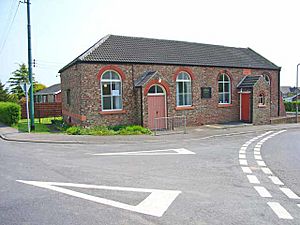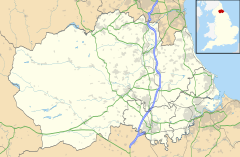Carlton, County Durham facts for kids
Quick facts for kids Carlton |
|
|---|---|
 Carlton Methodist Church |
|
| Population | 726 (2011) |
| OS grid reference | NZ396218 |
| Unitary authority |
|
| Ceremonial county | |
| Region | |
| Country | England |
| Sovereign state | United Kingdom |
| Post town | STOCKTON-ON-TEES |
| Postcode district | TS21 |
| Police | Cleveland |
| Fire | Cleveland |
| Ambulance | North East |
| EU Parliament | North East England |
| UK Parliament |
|
Carlton is a small village in County Durham, England. It is part of the Stockton-on-Tees area. In 2011, about 726 people lived here. Carlton is located a few miles northwest of the town of Stockton-on-Tees. It is also close to the village of Redmarshall.
Contents
A Look Back at Carlton's History
Carlton has a very long history. Even with new buildings today, the village still looks much like it did in medieval times. Houses face each other along the main street. This old layout likely dates back to the 11th or 12th century. This was a time of great change and rebuilding in the area.
The village is part of the church area of Redmarshall. This area was once under the control of the Bishop of Durham. Carlton is about 5 miles west of Stockton-on-Tees. It sits about 160 feet above sea level. For a long time, Carlton was mainly a farming village. Farmhouses and cottages lined the main street. A slow stream flowed along the south side of the village.
Around 1200 AD, Bishop Pudsey of Durham ordered a survey. This was the earliest record of Carlton. It showed 23 farmers and a miller lived there. One resident, William, had to help the Bishop with hunting. By the late 1300s, 124 people lived in Carlton. Villagers shared a common bakehouse.
Life in Carlton was much harder in the past. Until the early 1900s, the only water came from a village pump. Piped water arrived around 1895. But the pump was still used for many years.
How People Traveled and Worked
People used to travel by foot or horse. Then, a railway station opened east of the village around 1850. It was first called Carlton Station. This station became a busy place. It handled goods, chemicals, coal, and passengers. More houses were built for the workers. This made the village population grow a lot. Farmers used the railway to send milk to dairies. They would milk cows, cool the milk, and send it by horse to catch an early train. This made sure the milk was fresh for breakfast.
A bus service started in the 1920s. At first, the bus only ran twice a week. Now, buses run every weekday. In the 19th century, men with stallions visited farms. They helped local farmers breed their mares. Horses were the main way to travel back then. Cars slowly took over in the 20th century. Today, the village has more traffic. Some cars go faster than the 30 mph speed limit set in 1978.
Before modern farm machines, a steam thrashing machine visited farms. It would spend a day at each farm. Thrashing corn was a big event. About 20 local men and women worked from early morning until dark. The farmer's wife cooked big meals for everyone.
Village Changes and Community Spirit
Before World War II, Carlton had many natural spots. There were footpaths, duck ponds, orchards, and trees. Over time, roads were widened and old buildings removed. But the village greens are still lovely. Residents have planted bulbs, and the council helps keep them nice.
The Methodist Chapel was built in 1871. Services are held there every Sunday. It stands at the east end of the village. The 'Smiths Arms' pub is in the village center. It was built around 1900. It replaced an older inn nearby. The blacksmith's shop next to the pub was a busy place. People would share news and horses would get new shoes.
Carlton was once a farming village. There were five working farms before the war. Now, only one traditional farm remains. Children from Carlton went to Redmarshall church school. It closed in 1966. A new primary school opened in Bishopton.
In 1928, a group of women started a Women's Institute. They raised money to build a hall. The hall was finished in 1936. It has been very useful for the Women's Institute and the community. During the war, soldiers stayed there. Red Cross classes were held for first aid workers. The hall has also been used by clubs over the years.
The first post office opened in 1933. It was in a room in a cottage. Today, the post office is inside Carlton Village Stores. Public telephones arrived much later. In the past, traveling salesmen visited the village. Fruit, fish, and butchers came weekly by horse and cart.
In 1939, a committee helped with the war effort. Local people worked hard to raise money. A strong community spirit was important during the war. Groups like the Home Guard and Fire Brigade had good support. There are no records of serious crime in Carlton. This is probably why the village never had its own police officer.
Christmas Eve 1935 was a special day for Carlton. Electricity was turned on! Candles and oil lamps were no longer needed. Street lights were put in place in 1963. The village playing field was created in 1975. It was given to the parish by Mr. Fred Hall, a local farmer. His family had lived in the area since the 1700s.
A Parish Council was formed in 1956. It took the place of older village meetings. Seven members are on the council. They meet once a month to discuss local issues. Carlton has many old buildings, some are "listed" for their history. New homes have been built recently. This has made the population grow. Carlton is a nice place to live because it is a rural village close to the industrial area of Teesside.
Carlton was part of the Stockton-on-Tees Rural District for many years. In 1972, it became part of the new County of Cleveland. In 1841, 157 people lived in Carlton. By 1990, the population was 550. A strong community spirit still exists in the village. This is thanks to the Women's Institute, the Church, and the chapel.
Public Services in Carlton
Carlton has several public services for its residents:
- A sports field with a play area for children.
- A village green, which is a nice open space.
- A WI hall for community events.
- A chapel for religious services.
- A post office for mail and other services.
Famous People from Carlton
George Orwell, a famous writer, lived near Carlton from 1944 to 1945. He stayed at Greystone, the home of his wife's sister-in-law. He moved there with his wife Eileen and their adopted son, Richard. Their London flat had been damaged by bombs. The housekeeper remembered Orwell reading in the garden. He also sat by a window, reading or taking notes. This room looked out over the Whitton valley. It was a rural area with farmland and woods. While living here, Orwell finished his famous book, Animal Farm. This book is an allegory about Stalinist Russia. He left for France in 1945 to work as a war reporter.
Mary Elizabeth Andrew lived in Carlton her whole life. She worked as the clerk for the parish council for 62 years, from 1938 to 2000. There is a special bench and stone on the village greens to remember her.
Images for kids
See also
 In Spanish: Carlton (Durham) para niños
In Spanish: Carlton (Durham) para niños



